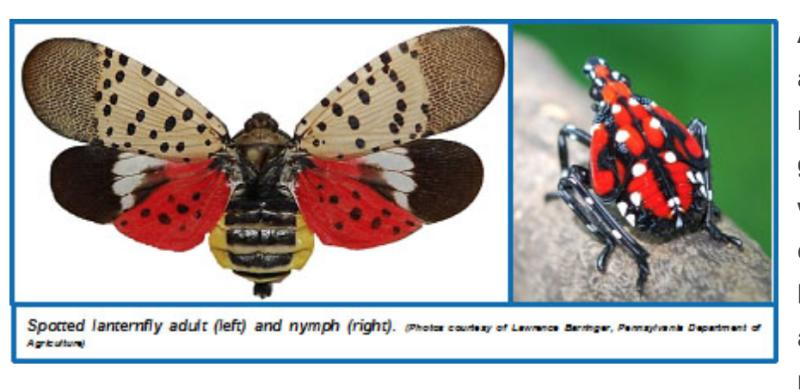Are Spotted Lanternflies Toxic to Pets?

- posted: Oct. 03, 2020
Are Spotted Lanternflies Toxic to Pets?
The Spotted Lanternfly is an invasive insect species spreading across the United States that can damage fruit trees—particularly apples and grapes—in addition to other plants. As of March 2020, the York Dispatch reported that lanternflies have been found in York County, especially in Hellam and West Manchester townships.
There have been a few posts floating around on Facebook suggesting lanternflies are toxic to dogs and cats. One post even states they can cause blisters on pets’ paws and caused seizures in a dog after being ingested. Are spotted lanternflies really harmful to our pets? Here’s what we know.
First, this is still a somewhat new species in the United States, so information is still being learned about the spotted lanternfly and its impact on plants and animals in Pennsylvania. However, these insects do not bite or sting and there are no reports of serious toxicity. I can find no information that lanternflies cause seizures, so this information appears to be false. One report from the Delaware Department of Agriculture mentions that dogs may become ill and develop blisters on their paws from eating the insects, but this was the only reference that mentioned blisters, so it’s not clear how common this may be.
It is thought that spotted lanternflies may have a bitter taste due to the types of plants they eat. Birds seem to avoid them, and, the insects’ brightly colored wings may be a warning sign that they taste bad. The most common symptoms associated with dogs or cats who have ingested a spotted lanternfly seem to be drooling, vomiting and loss of appetite. It should be noted that these symptoms could be caused by eating many other types of insects or plants and, of course, vomiting can be a symptom of many types of illnesses. If you have witnessed your pet eating a lanternfly or if your pet is exhibiting symptoms of drooling, vomiting or stops eating, have him or her checked by a vet. Spotted lanternflies do not appear to pose a serious threat to pets, but discourage pets from eating them and, since symptoms like vomiting are common to many illnesses, have pets checked if exhibiting symptoms.
Interestingly, dogs are being trained by the University of Pennsylvania to see if they can sniff out and identify spotted lanternfly egg masses by odor. If the lanternflies can be identified as eggs, they can be destroyed early in their lifecycle before causing damage. Dogs in training are displaying about a 95% success rate in identifying eggs with their amazing sense of smell!
One final word about spotted lanternflies: sticky bands sold to protect trees and trap lanternflies are effective, but may also trap other wildlife such as birds, lizards and beneficial insects like bees. If using these sticky bands to trap lanternflies, cover the band with a mesh barrier to reduce capturing other wildlife.
This blog brought to you by the Patton Veterinary Hospital serving Red Lion, York and the surrounding communities.
https://www.sciencedaily.com/releases/2019/02/190211105408.htm
Photo from PA Dept. of Agriculture
Schedule an appointment with our team of veterinarians today at (717) 246-3611!
Location
Patton Veterinary Hospital
425 E Broadway
Red Lion, PA 17356
